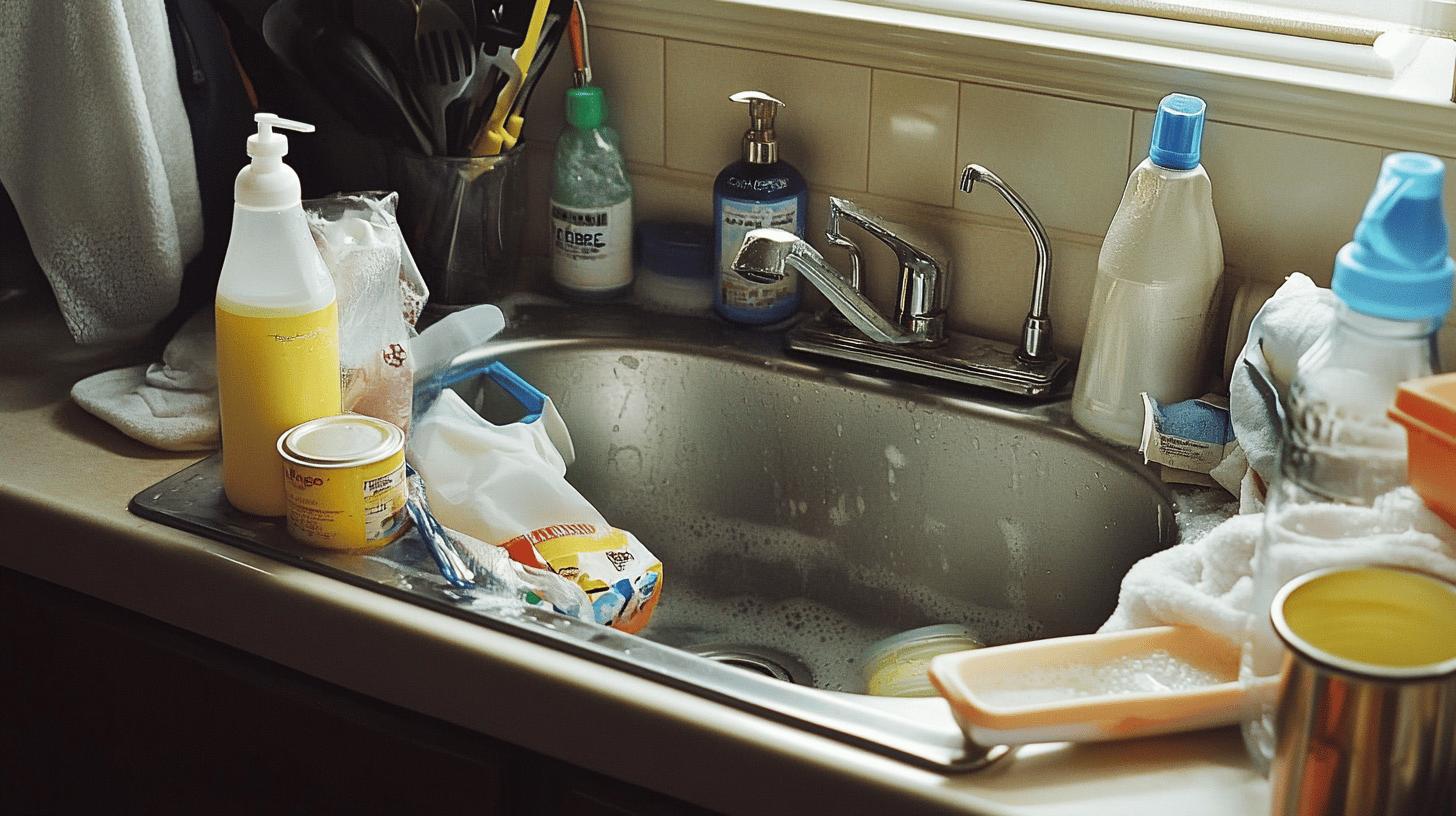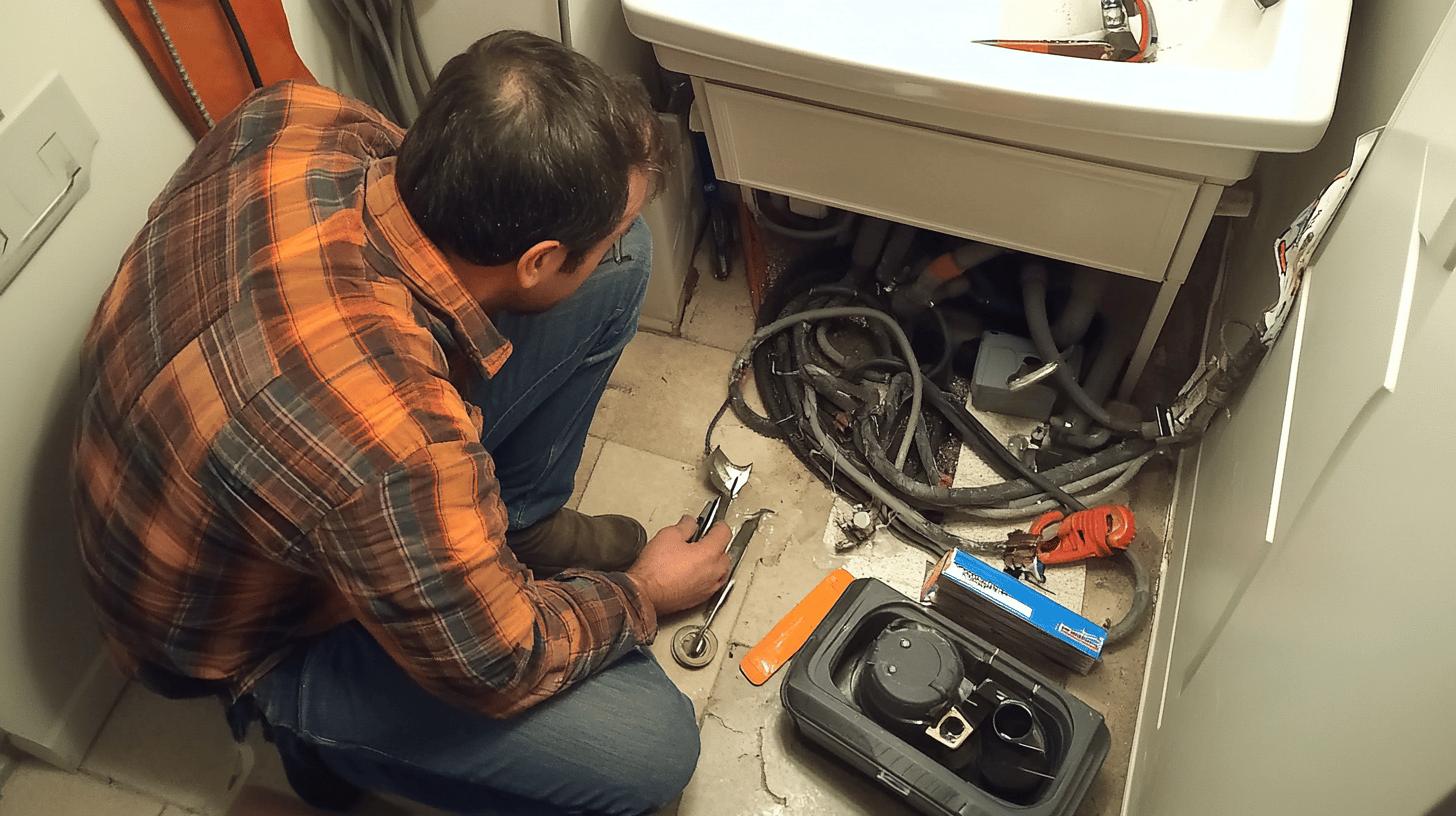TL;DR:
- Common clog causes: hair buildup, grease, food particles, soap scum, mineral deposits.
- Urgent issues require attention: toilet clogs risk backflow; shower clogs cause standing water/mold.
- DIY unclogging methods: plunger, wire coat hanger, drain snake, hot water, Coke/Pepsi, baking soda/vinegar.
- Tools: Plungers (toilets/sinks), drain snakes (deep clogs), hair removal tools (bathroom drains), chemical cleaners (use sparingly).
- Signs to call a professional: persistent clogs, recurring blockages, foul odors, water back-up.
- Preventative measures: routine drain maintenance, use drain filters, avoid pouring grease/large food down drains.
Have you ever stepped into a shower and found yourself standing in a pool of water that just won’t drain? Clogged drains can really mess up your day. It’s important to know why clogs happen and that different types of drains need different fixes. In this guide, we’ll share some simple tips to help you unclog your drains before it turns into a bigger, more expensive problem. Whether it’s your kitchen sink or your shower, knowing what to do will keep things flowing smoothly. Ready to get started? Let’s dive in!
Understanding Drain Unclogging Basics
Knowing the different types of drains and what usually causes clogs is super important for fixing them effectively. Each drain—whether it’s in your sink, toilet, or shower—comes with its own set of challenges. For example, shower drains often get clogged with hair and soap scum, while kitchen sinks struggle with grease and food scraps. Recognizing these patterns helps you choose the right unclogging method.
Clogged drains can lead to various problems depending on their type. In sinks, a clog can cause slow draining and even overflow. Toilet clogs can be much worse, potentially causing backflow and water damage if not dealt with quickly. Shower clogs can create standing water and mold issues. Understanding these problems helps you figure out which clogs need immediate attention and which ones you can fix with easier solutions.
Common clog causes include:
- Hair buildup
- Grease accumulation
- Food particles
- Soap scum
- Mineral deposits
Dealing with clogs quickly is key to preventing bigger problems down the road. If you ignore slow drains, you might end up with serious blockages that need major repairs. Keeping up with regular maintenance and acting fast on early signs can save you time and money while extending the life of your plumbing system. Being proactive helps you avoid costly fixes or replacements later on.
DIY Drain Unclogging Methods

Before you reach out to a pro, give some DIY methods a shot for that clogged drain. There are different approaches you can try, depending on how bad the clog is and where it’s located. You can use a plunger, a wire coat hanger, a drain snake, or even pour in some hot water, Coke, or baking soda mixed with vinegar. Whether it’s your kitchen sink blocked with food or a bathroom drain clogged with hair, these tricks can provide quick, temporary relief.
- Plunger: Create a seal over the drain and pump vigorously to dislodge the block. Ensure enough water covers the plunger’s head for better suction.
- Wire Coat Hanger: Straighten the hanger, leaving a small hook. Insert it into the drain to fish out hair or other debris.
- Drain Snake: Insert into the drain until resistance is felt. Rotate to break up the clog, then pull it out with debris.
- Hot Water: Pour boiling water in stages, letting it work through the clog. This is effective for grease in kitchen drains.
- Coke or Pepsi: The acidity can help break minor blockages. Pour a bottle down the drain and let it sit for an hour before flushing with hot water.
- Baking Soda and Vinegar: Pour a cup of baking soda then a cup of vinegar. Let it fizz for 15-30 minutes before rinsing with hot water.
How well a method works depends on the type and location of the clog. For instance, a plunger is great for toilet clogs, while a drain snake is better for deeper blockages. Baking soda and vinegar are effective for minor organic clogs, and hot water is good for melting kitchen grease. Knowing what caused the clog and where it is can help you pick the best fix.
While DIY methods can provide quick relief, they might not solve the problem for good. If a clog keeps coming back after several attempts to fix it, it’s time to call in a professional plumber. They have the right tools and know-how to tackle tough clogs, ensuring a thorough and lasting solution.
Tools and Products for Drain Unclogging
Picking the right tool to unclog drains is super important for solving the problem without causing more damage. Whether you’re dealing with a small or a big clog, using the right tool makes all the difference. Plungers work well for toilets and sinks, while drain snakes are great for tackling tough clogs deeper in the pipes. For bathroom drains clogged with hair, there are specialized tools that clear the blockage without harming your plumbing.
Chemical drain cleaners are popular because they’re easy to use and can dissolve stubborn clogs. But be careful—they can damage your pipes over time, especially if you use them too much. Plus, the harsh chemicals can harm the environment and contaminate water supplies. So, think twice before reaching for those chemical cleaners!
| Tool/Product | Use | Safety Considerations |
|———————|———————————————-|———————————————————-|
| Plunger | Dislodging blockages in toilets and sinks | Ensure proper seal; use with caution to prevent splashes |
| Drain Snake | Removing deep clogs in pipes | Avoid aggressive use to prevent pipe damage |
| Hair Removal Tool | Clearing hair from bathroom drains | Use gently to avoid scratching fixtures |
| Chemical Drain Cleaner | Dissolving organic material and grease | Follow label instructions; consider environmental impact |
When picking products for unclogging drains, it’s super important to think about safety and the environment. Always go for tools and methods that are less likely to hurt your plumbing and the planet. Mechanical tools, like plungers and snakes, are a better choice because they’re gentler on your pipes compared to chemical cleaners. If you do need to use chemicals, use them carefully and follow the instructions to keep your home and the environment safe.
When to Call a Professional for Drain Unclogging

Knowing when to call a professional can save you time and prevent further plumbing damage. You should reach out for help if you have stubborn clogs that won’t go away, keep experiencing blockages that hint at deeper problems, notice bad smells, or see water backing up from multiple drains. These signs often point to issues that are too complex for DIY solutions.
- Clogs that persist after multiple DIY attempts
- Frequent blockages in the same drain
- Unpleasant odors indicating deeper issues
- Water backing up in multiple drains
Hiring professionals comes with many benefits. They use advanced tools like high-pressure water jetters and cameras for deep cleaning and accurate diagnosis. While their services usually cost between $100 and $300, this investment can save you from pricier repairs down the line. Pros not only clear existing clogs but also tackle the root causes, ensuring your plumbing flows smoothly in the long run.
Preventative Measures for Drain Unclogging
Regular maintenance is essential for preventing clogs and keeping your plumbing in good shape. By routinely checking and cleaning drains, you can catch blockages early, extending your plumbing’s life and saving money on emergency repairs.
Using drain filters is a smart way to stop clogs, as they catch hair, food, and soap scum. Be cautious about what you send down the drain; avoid pouring grease and large food scraps into the sink.
Set a maintenance schedule to clean filters and flush drains with hot water or a gentle solution. Sticking to this routine will ensure smooth water flow and reduce unexpected clogs, protecting your plumbing system for hassle-free use.
Final Words
Getting to know how to unclog drains is super important, especially since stuff like debris and grease buildup are common culprits. DIY methods can help in a pinch, but they have their limits and sometimes you need special tools or a pro to deal with tough clogs. Choosing the right tool or product is essential, and it’s also good to think about safety and how it affects the environment. Knowing when to call a professional can save you time and money later on. Plus, taking preventive steps like regular maintenance and using drain filters can keep your drains clear and working well, helping everything run smoothly at home.
FAQ
How can I unclog a drain with standing water?
A: To unclog a drain with standing water, use a plunger or a drain snake. Ensure to create a tight seal with the plunger or insert the snake carefully to dislodge the clog.
Why should you never use baking soda and vinegar to unclog a drain?
A: Baking soda and vinegar may not be effective on all clogs and can sometimes worsen blockages by breaking down partially. This mixture is best for minor clogs or build-up.
What is the best thing to unblock a drain?
A: The best way to unblock a drain depends on the clog type. Common tools include a plunger for general use, a snake for deep clogs, or a chemical cleaner for tough blockages.
Can I unclog my main drain myself?
A: You can try using a plunger or a professional-grade drain snake to unclog your main drain, but persistent or severe clogs may require professional assistance.
How do I unclog a drain with hair?
A: Use a hair removal tool or a flexible drain snake to effectively remove hair clogs. Pull the clog gently to avoid pushing it further down.
How do I unclog a shower drain?
A: Unclog a shower drain by removing the cover and using a drain snake or hair removal tool. You can also try using a mix of hot water and dish soap.
What are some DIY drain unclogging methods?
A: DIY methods include using a plunger, wire coat hanger, drain snake, hot water, or a baking soda and vinegar mixture. Each method’s success varies based on clog severity and location.
What tools and products are effective for drain unclogging?
A: Tools like plungers, drain snakes, and hair removal tools are helpful. Use chemical drain cleaners cautiously due to potential pipe damage and environmental impact.
When should I call a professional for drain unclogging?
A: Call a professional if you experience persistent clogs, repeated DIY failure, gurgling noises, or water backups. Professionals offer long-term solutions and use specialized equipment.
How can I prevent future drain clogs?
A: Regular maintenance, using drain filters, and avoiding disposing of unsuitable materials down drains can prevent future clogs. Establish a maintenance schedule to keep drains clear.

